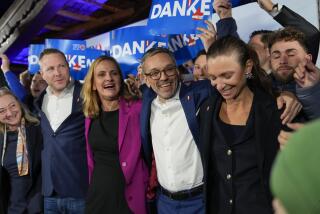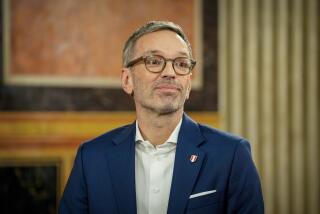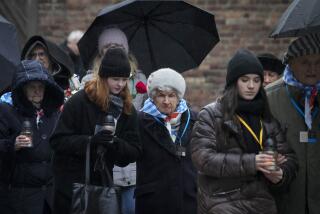50th Anniversary of Takeover by Hitler : Austria to Recall Its Darker Side in War
VIENNA — Austria prefers to depict itself as the land of “The Sound of Music,” of snowy ski slopes and lively coffeehouses, a warm amalgam of coziness and Old World charm.
The nation managed to emerge relatively unscathed from World War II. The Allies declared it the “first victim” of Adolf Hitler.
But there was a darker side to Austria’s relationship with Hitler, who was born an Austrian, and it will be remembered here today on the 50th anniversary of the anschluss , the annexation by Nazi Germany.
Observance of the anniversary will underscore the fact that Austria was as much accomplice as victim.
The ceremonies will be sharpened by the controversy over President Kurt Waldheim, who has been implicated, as an officer in the German army, in what an investigating committee of historians said last month were actions “contrary to the law of war and principles of humanity.” Waldheim, who served in the Balkans in an army unit that has been implicated in wartime atrocities, was “in close proximity” to war crimes and did nothing to prevent them, the committee concluded.
The truth is that many Austrians welcomed annexation by Germany. Hitler was personally acclaimed in Austria’s large cities. Many of Austria’s young men, like Waldheim, served willingly in the German army.
Also, the Austrian brand of Nazism was not substantially different from that of its neighbor, and in some ways, it dealt just as severely with the Jewish community.
Many Austrians have found it difficult to face such facts. Some observers refer to “collective amnesia.”
“For years we have shied away from looking honestly at ourselves in the mirror, from accepting our responsibility,” said Freda Meissner-Blau, a leader of the radical Greens party in the Federal Assembly. “But now I think it is a good thing that we are forced to deal with our role in history. We have to pass through this period of looking at history in order to get clear of it.”
‘Safe Escape’
Erika Weinzierl, a professor at Vienna University, said, “We felt that history had come to our rescue and we were provided with a safe escape through the net of the past.”
Many Austrians would prefer not to resurrect the ghosts of the past, to reopen the scars of the Nazi Era. But the country’s leaders decided to observe the anniversary with public meetings and statements.
Chancellor Franz Vranitzky has said: “We must lift up the carpet, open the window, open the door, and deal with some aspects of history we are not proud of. We must do everything to avoid these things happening again.”
Even Joerg Haider, leader of the Freedom Party, which has attracted right-wing voters, said, “It is necessary to inform ourselves, especially the young, about these events in our history.”
How did the anschluss come about? Thomas Chorherr, who is executive editor of the conservative daily Die Presse, explains it as follows:
“Remember that after World War I, Germany kept most of its territory, except for Alsace-Lorraine. But the Austro-Hungarian empire was split up, and we were left with only 6 million people out of 51 million and without our hinterlands to the east.
“We felt very vulnerable with only our German-speakers left. So many Austrians began to look toward Germany for actual survival as a political entity.”
Between the wars, Austria faced problems of runaway inflation, high unemployment and political instability, with political parties forming paramilitary units that clashed in the streets.
In 1933, the Nazi Party of Austria was outlawed. The next year, in retaliation, the Nazis assassinated Chancellor Engelbert Dollfuss, bringing the nation close to civil war.
On March 11, 1938, with the approval of the new chancellor, Kurt Schuschnigg, Hitler announced the annexation of Austria. The following day German troops moved in.
Freda Meissner-Blau remembers the day vividly.
“I was an 11-year-old girl in pigtails in the city of Linz,” she said. “The announcement was made on March 11, and the next day there was no school. My older sister, Doris, and I were told not to leave the house, but of course we did.
“We went into town and saw thousands of people lined up along the main street. They were screaming that they wanted to see the Fuehrer. We crept through to the front of the crowd and saw the German soldiers coming in like liberators.
“Then, on the balcony of the hotel, there came a man with watery blue eyes, and everybody screamed, ‘Heil!’ I looked at him and was terribly disappointed. It was Hitler, but he was uninteresting-looking, mediocre, and not at all heroic.”
Soon after the anschluss , Jews were brutally repressed, as were members of the Austrian resistance. Over a period of seven years, 35,000 Austrians active in the resistance were executed by the Germans; 115,000 died in concentration camps, including 65,000 Jews.
After the war, Austria was occupied by the four Allied powers. A small-scale denazification program was undertaken.
In 1955, with the encouragement of the United States and the Soviet Union, Austria declared itself neutral, and the occupying forces left.
Austria became a haven for refugees and a transit point for Jews coming out of the Soviet Union, as well as headquarters for several agencies of the United Nations. The past was conveniently forgotten, partly because the 600,000 former members of Nazi organizations and their families accounted for 20% of Austria’s voters.
The 1938-45 period is given little more than a glance in school history classes.
Austria’s ability to forget the past has given rise to a popular saying: “The Austrians have convinced the world that Hitler was a German and Beethoven was an Austrian.”
One aspect of the anniversary observance ties in with the Waldheim controversy: the possibility of reviving Austria’s latent anti-Semitism.
The other day Edgar M. Bronfman, president of the World Jewish Congress and chairman of Seagram distilleries, urged the European Communities to deny Austria membership as long as Waldheim is president. Several Austrian officials have responded in strong terms.
Haider, the Freedom Party leader, said: “That could lead to even more anti-Semitism. He is playing with fire and should know better. Bronfman should stick to whiskey-making and not foreign policy.”
According to many observers, anti-Semitism continues to figure in Austrian life. Karl Pfeifer, a leader in Vienna’s Jewish community, which numbers 7,500, said Wednesday: “This is one of the few countries in Europe where anti-Semitism is used by politicians. Here you have an official like Karl Gruber, a former foreign minister and ambassador to the United States, who criticized the military historians investigating Waldheim with the remark, ‘The German (member) is a socialist, and four others are of Jewish descent.’
“How do you account for that? Or the fact that a mass newspaper, the Kronen Zeitung, runs anti-Semitic stories and letters to the editors.”
Pfeifer also challenged Austrians who have suggested that Austria opposed Hitler long before anyone else in Europe.
“At the time they’re talking about,” he said, “half the government was Nazi, so they couldn’t really say they went to Western governments for help and were ignored. Further, two days after the anschluss , the Austrian soldiers were integrated into the German army. For Vice Chancellor Alois Mock to say that Austria fought Nazism for five years before the anschluss is a blatant lie.”
Among the exhibits opening this week in conjunction with the anniversary is one at Vienna City Hall that traces the rise and fall of the Nazis in Austria. Black and white photos illustrate the joy with which Hitler and the German army were received. Others show the humiliation and banishment of the Jews.
“We wanted to present both sides of the anschluss in a factual setting without elaborate comment,” said historian Siegwald Ganglmair, who works with the Archives of the Austrian Resistance.
“The danger with all this publicity now is that people will get fed up and forget about it again. But in the last three years, we have been able to talk much more openly about the problem, including the rise of neo-fascism in Austria these days.”
Simon Wiesenthal, the famous Nazi hunter, believes that the glare of publicity has been a good thing.
“The old generation kept silent about the past,” he said in his office here. “I believe in the young generation. They ask questions about their fathers, and this can make things better.”
Meissner-Blau, the Greens member of the Federal Assembly, said: “The observance may be something of a slimy Austrian compromise--wanting to do something about the anschluss but not wanting to hurt one another.”
Historian Ganglmair: “If the Waldheim case has a positive side, it is that in the last three years we have tried to come to terms with our past, to talk about it, so that we can avoid such behavior in the future. We would like to make sure that history does not repeat itself.”
More to Read
Sign up for Essential California
The most important California stories and recommendations in your inbox every morning.
You may occasionally receive promotional content from the Los Angeles Times.










